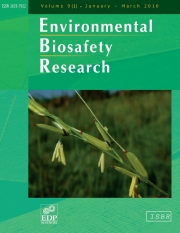Crossref Citations
This article has been cited by the following publications. This list is generated based on data provided by
Crossref.
Lang, A.
Brunzel, S.
Dolek, M.
Otto, M.
and
Theißen, B.
2011.
Modelling in the light of uncertainty of key parameters: a call to exercise caution in field predictions of
Bt
-maize effects
.
Proceedings of the Royal Society B: Biological Sciences,
Vol. 278,
Issue. 1708,
p.
980.
Perry, J. N.
Devos, Y.
Arpaia, S.
Bartsch, D.
Gathmann, A.
Hails, R. S.
Kiss, J.
Lheureux, K.
Manachini, B.
Mestdagh, S.
Neemann, G.
Ortego, F.
Schiemann, J.
and
Sweet, J. B.
2011.
The usefulness of a mathematical model of exposure for environmental risk assessment.
Proceedings of the Royal Society B: Biological Sciences,
Vol. 278,
Issue. 1708,
p.
982.
Ammann, Klaus
2012.
Encyclopedia of Sustainability Science and Technology.
p.
4492.
SCHUPPENER, MECHTHILD
MÜHLHAUSE, JULIA
MÜLLER, ANNE‐KATRIN
and
RAUSCHEN, STEFAN
2012.
Environmental risk assessment for the small tortoiseshell Aglais urticae and a stacked Bt‐maize with combined resistances against Lepidoptera and Chrysomelidae in central European agrarian landscapes.
Molecular Ecology,
Vol. 21,
Issue. 18,
p.
4646.
Perry, Joe N.
Devos, Yann
Arpaia, Salvatore
Bartsch, Detlef
Ehlert, Christina
Gathmann, Achim
Hails, Rosemary S.
Hendriksen, Niels B.
Kiss, Jozsef
Messéan, Antoine
Mestdagh, Sylvie
Neemann, Gerd
Nuti, Marco
Sweet, Jeremy B.
and
Tebbe, Christoph C.
2012.
Estimating the effects of Cry1F Bt‐maize pollen on non‐target Lepidoptera using a mathematical model of exposure.
Journal of Applied Ecology,
Vol. 49,
Issue. 1,
p.
29.
Holst, Niels
Lang, Andreas
Lövei, Gabor
and
Otto, Mathias
2013.
Increased mortality is predicted of Inachis io larvae caused by Bt-maize pollen in European farmland.
Ecological Modelling,
Vol. 250,
Issue. ,
p.
126.
Ammann, Klaus
2013.
Sustainable Food Production.
p.
913.
Perry, Joe N.
Arpaia, Salvatore
Bartsch, Detlef
Birch, A. Nick E.
Devos, Yann
Gathmann, Achim
Gennaro, Andrea
Kiss, Jozsef
Messéan, Antoine
Mestdagh, Sylvie
Nuti, Marco
Sweet, Jeremy B.
and
Tebbe, Christoph C.
2013.
No evidence requiring change in the risk assessment of Inachis io larvae.
Ecological Modelling,
Vol. 268,
Issue. ,
p.
103.
Hilbeck, Angelika
Weiss, Gabriele
Oehen, Bernadette
Römbke, Jörg
Jänsch, Stephan
Teichmann, Hanka
Lang, Andreas
Otto, Mathias
and
Tappeser, Beatrix
2014.
Ranking matrices as operational tools for the environmental risk assessment of genetically modified crops on non-target organisms.
Ecological Indicators,
Vol. 36,
Issue. ,
p.
367.
Camastra, Francesco
Ciaramella, Angelo
and
Staiano, Antonino
2014.
A note on some mathematical models on the effects of Bt-maize exposure.
Environmental and Ecological Statistics,
Vol. 21,
Issue. 3,
p.
477.
Lang, Andreas
and
Otto, Mathias
2015.
Feeding Behaviour on Host Plants May Influence Potential Exposure to Bt Maize Pollen of Aglais Urticae Larvae (Lepidoptera, Nymphalidae).
Insects,
Vol. 6,
Issue. 3,
p.
760.
Yaqoob, Amina
Shahid, Ahmad Ali
Samiullah, Tahir Rehman
Rao, Abdul Qayyum
Khan, Muhammad Azmat Ullah
Tahir, Sana
Mirza, Safdar Ali
and
Husnain, Tayyab
2016.
Risk assessment of Bt crops on the non-target plant-associated insects and soil organisms.
Journal of the Science of Food and Agriculture,
Vol. 96,
Issue. 8,
p.
2613.
Leclerc, Melen
Walker, Emily
Messéan, Antoine
and
Soubeyrand, Samuel
2018.
Spatial exposure-hazard and landscape models for assessing the impact of GM crops on non-target organisms.
Science of The Total Environment,
Vol. 624,
Issue. ,
p.
470.
Arpaia, Salvatore
Baldacchino, Ferdinando
Bosi, Sara
Burgio, Giovanni
Errico, Simona
Magarelli, Rosaria Alessandra
Masetti, Antonio
and
Santorsola, Salvatore
2018.
Evaluation of the potential exposure of butterflies to genetically modified maize pollen in protected areas in Italy.
Insect Science,
Vol. 25,
Issue. 4,
p.
549.
Fahse, Lorenz
Papastefanou, Phillip
and
Otto, Mathias
2018.
Estimating acute mortality of Lepidoptera caused by the cultivation of insect-resistant Bt maize – The LepiX model.
Ecological Modelling,
Vol. 371,
Issue. ,
p.
50.
Lang, Andreas
Lee, Marina
Dolek, Matthias
Berchtold, Julitta
and
Otto, Mathias
2019.
Laboratory tests with Lepidoptera to assess non-target effects of Bt maize pollen: analysis of current studies and recommendations for a standardised design.
Environmental Sciences Europe,
Vol. 31,
Issue. 1,
Lang, Andreas
Kallhardt, Franz
Lee, Marina S.
Loos, Jacqueline
Molander, Mikael A.
Muntean, Iulia
Pettersson, Lars B.
Rákosy, László
Stefanescu, Constantí
and
Messéan, Antoine
2019.
Monitoring environmental effects on farmland Lepidoptera: Does necessary sampling effort vary between different bio-geographic regions in Europe?.
Ecological Indicators,
Vol. 102,
Issue. ,
p.
791.
Pinheiro, Patricia Valle
and
de Faria, Josias Correa
2020.
GMOs.
Vol. 19,
Issue. ,
p.
87.
Baudrot, Virgile
Walker, Emily
Lang, Andreas
Stefanescu, Constanti
Rey, Jean-François
Soubeyrand, Samuel
and
Messéan, Antoine
2021.
When the average hides the risk of Bt-corn pollen on non-target Lepidoptera: Application to Aglais io in Catalonia.
Ecotoxicology and Environmental Safety,
Vol. 207,
Issue. ,
p.
111215.
Baudrot, Virgile
Lang, Andreas
Stefanescu, Constanti
Soubeyrand, Samuel
and
Messéan, Antoine
2021.
Extension of the spatially‐ and temporally‐explicit “briskaR‐NTL” model to assess potential adverse effects of Bt‐maize pollen on non‐target Lepidoptera at landscape level.
EFSA Supporting Publications,
Vol. 18,
Issue. 4,


